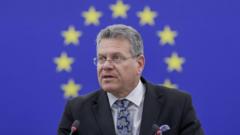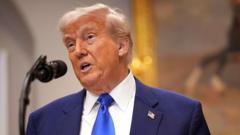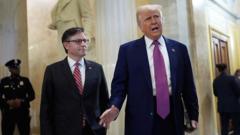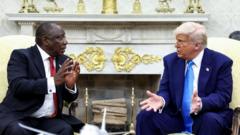The Trump administration's ultimatum on tariffs signals a pivotal shift in international trade negotiations, particularly affecting established alliances.
**Trump's 50% Tariff Proposal on EU Imports: A Game Changer in Trade Dynamics**

**Trump's 50% Tariff Proposal on EU Imports: A Game Changer in Trade Dynamics**
Analyzing the impact of Trump's tariff threats on US-EU economic relations.
In an unprecedented escalation of trade tensions, President Trump has declared his intention to impose a staggering 50 percent tariff on European imports, effective June 1. This move comes amidst ongoing negotiations with the European Union aimed at addressing perceived unfair trade practices that, according to Trump, have created a “totally unacceptable” trade imbalance.
In a post on Truth Social, Trump stated that the European Union, which he accused of manipulating the trading system to disadvantage the United States, has proven difficult to negotiate with. “Our discussions with them are going nowhere!” he emphasized, casting the EU as a commercial adversary rather than an ally.
This announcement has ramifications for the nearly $5 billion in goods and services traded daily between the two economies. Objects of potential tariffs include a wide array of sectors, notably automobiles and pharmaceuticals, an approach that diverges sharply from conventional diplomacy where mutual concessions are sought.
While the EU has approached these discussions with hopes of steering toward beneficial outcomes, the Trump administration appears more focused on leveraging these economic pressures to gain ground in negotiations rather than cultivating cooperative relations. This stance has already led to multiple rounds of tariffs since Trump's administration began in January, targeting industries including steel and aluminum.
As the clock ticks down to the proposed tariffs, stakeholders on both sides are bracing for potential fallout from this aggressive economic strategy. The hope for a resolution now rests on whether cooler heads can prevail amid intense pressure tactics. The unfolding saga raises critical questions about the future of transatlantic trade and geopolitical rapport as the negotiating table grows increasingly fraught.
In a post on Truth Social, Trump stated that the European Union, which he accused of manipulating the trading system to disadvantage the United States, has proven difficult to negotiate with. “Our discussions with them are going nowhere!” he emphasized, casting the EU as a commercial adversary rather than an ally.
This announcement has ramifications for the nearly $5 billion in goods and services traded daily between the two economies. Objects of potential tariffs include a wide array of sectors, notably automobiles and pharmaceuticals, an approach that diverges sharply from conventional diplomacy where mutual concessions are sought.
While the EU has approached these discussions with hopes of steering toward beneficial outcomes, the Trump administration appears more focused on leveraging these economic pressures to gain ground in negotiations rather than cultivating cooperative relations. This stance has already led to multiple rounds of tariffs since Trump's administration began in January, targeting industries including steel and aluminum.
As the clock ticks down to the proposed tariffs, stakeholders on both sides are bracing for potential fallout from this aggressive economic strategy. The hope for a resolution now rests on whether cooler heads can prevail amid intense pressure tactics. The unfolding saga raises critical questions about the future of transatlantic trade and geopolitical rapport as the negotiating table grows increasingly fraught.






















